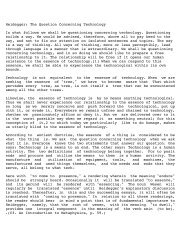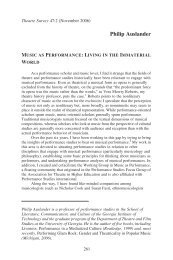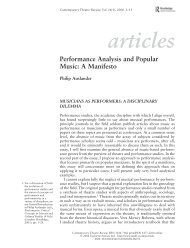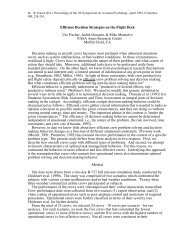INTERACTION DESIGN PRINCIPLES FOR INTERACTIVE ...
INTERACTION DESIGN PRINCIPLES FOR INTERACTIVE ...
INTERACTION DESIGN PRINCIPLES FOR INTERACTIVE ...
You also want an ePaper? Increase the reach of your titles
YUMPU automatically turns print PDFs into web optimized ePapers that Google loves.
working on a computer is not a solitary activity, but one that is capable of convening an<br />
active community around an iTV program.<br />
Screen resolution<br />
(amount of information<br />
displayed)<br />
Table 4.1 Televisions versus Computers<br />
Television Computers<br />
Relatively poor Varies from medium-sized<br />
screens to potentially very<br />
large screens<br />
Input devices Remote control and optional<br />
wireless keyboard that are<br />
best for small amounts of<br />
input and user actions<br />
100<br />
Mouse and keyboard sitting<br />
on desk in fixed positions<br />
leading to fast homing time<br />
for hands<br />
Viewing distance Many feet A few inches<br />
User posture Relaxed, reclined Upright, straight<br />
Room Living room, bedroom Home office (paperwork,<br />
(ambiance and tradition tax returns, etc., close by;<br />
implies relaxation)<br />
ambiance implies work)<br />
Integration opportunities Various broadcast shows Productivity applications,<br />
with other things on the<br />
user’s personal data, user’s<br />
same device<br />
work data<br />
Number of users Social: Many people can see Solitary: Few people can<br />
screen (often, several people see the screen (user is<br />
will be in the room when the usually alone while<br />
TV is on)<br />
computing)<br />
User engagement Passive: The viewer receives Active: User issues<br />
whatever the network commands and the<br />
executives decide to put on computer obeys<br />
More importantly, with increasing exposure to interactive programming, and with<br />
increasingly access to PVRs and VOD systems, television viewers are slowly moving<br />
away from the passive model of watching whatever the network executives decide to air<br />
into a more active model where they are able to exert a great deal of control over what<br />
they watch and when they watch it.














